Nov 02, 2025
Nov 02, 2025
The Decline of the Mughal Empire
In 1707, at the death of Aurangzeb, the Mughal empire was apparently intact and was still the premier power in the subcontinent. In 30 years, by 1739, the Mughal empire would have ceased to exist as a viable political entity. What caused this radical change?
Firstly, appearances were deceiving right from the end of Aurangzeb’s reign. The emperor had exhausted himself, and a large part of the empire’s resources, in fighting what were to prove ultimately fruitless wars in the Deccan. His orthodoxy had alienated large sections of the population which were hitherto allied to or at peace with the Mughals, among these were the Marathas, the Sikhs and the Rajputs. Governors of the Mughal empire also took advantage of growing feebleness – the nawabs of Bengal, Oudh and Hyderabad were soon to establish quasi-independent states which owed only nominal allegiance to Delhi.
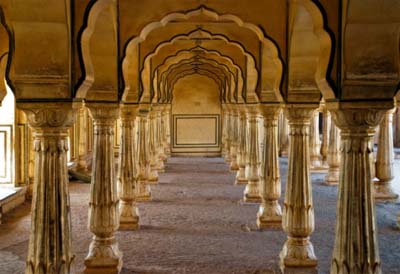 Some historians have associated the fall of the Mughals with excessive decadence, which led to increasing demands on the peasantry and the alienation of the supporting classes. The truth is probably a mixture of all these, as well as the fact that the Mughal empire had reached the maximum possible limit for an absolute monarchy. Aurangzeb’s long reign was followed by fratricidal warfare amongst his successors and brief rules, some even as short as weeks, until the final sack of Delhi by the Persian Nadir Shah in 1739.
Some historians have associated the fall of the Mughals with excessive decadence, which led to increasing demands on the peasantry and the alienation of the supporting classes. The truth is probably a mixture of all these, as well as the fact that the Mughal empire had reached the maximum possible limit for an absolute monarchy. Aurangzeb’s long reign was followed by fratricidal warfare amongst his successors and brief rules, some even as short as weeks, until the final sack of Delhi by the Persian Nadir Shah in 1739.
The absence of a strong central power paved the way for the entry of European powers, who were beginning to realize the lucrative potential of trade with India. Whereas during the time of the Mughals, the French and the British were content with trade concessions, it was during the interregnum of the late 18th century that the British and the French began to actively interfere in sub-continental politics. They were aided immensely by the fact that the native rulers could never form a lasting alliance against them, and so could be tackled one after the other. In the south, for example, the British dealt separately with Haider Ali and his son Tipu Sultan, and only then turned their attention to the Marathas.
The French and the British also competed with each other for supremacy in the subcontinent, but in the end it would ultimately be the British who would emerge victorious.
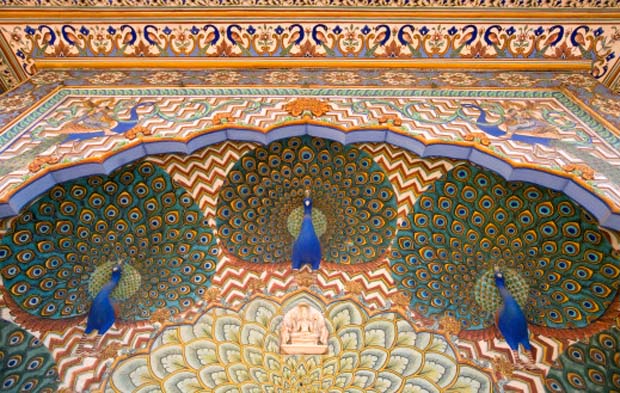
Princely States and their Architecture
The confusion accompanying the decline of the Mughal empire saw an abundance of new architecture at the new seats of regional power by the Rajputs, Sikhs, Marathas and the nawabs of Oudh, Bengal and Hyderabad. Hindu rulers started to construct memorials to their dead, much after the style of the Mughals, and restarted the construction of lavish temples, neglected for long because of the lack of power and finances. The Sikhs, persecuted for long by the later Mughals, pillaged Mughal building in their turn to build their own gurudwaras or temples. The nawabs built lavish gardens, tombs, mosques and palaces. Their was no longer a dominant style, but a hybrid where Gujarati, Bengali, Deccan and Persian elements fused to produce an eclectic strain of building.
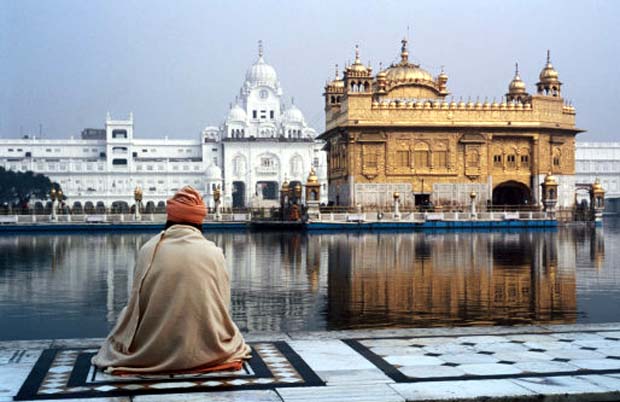
Late mediaeval Rajput architecture was noted both for its town planning and urban architecture. Rulers patronized research into ancient treatises and shastras of Hindu architecture and attempts were made to build accordingly. It would be fair, thus, to discuss two notable examples.
Jaisalmer
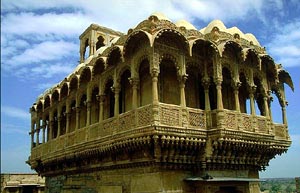 Jaisalmer is particularly noted for its havelis or private houses belonging to the noblesse. Here the court style fusing Mughal and Rajput elements was first emulated by Rawal Amar Singh (1661-1702) for the palaces and temples surrounding the lake and at Bada Bagh. His 18th and 19th century successors continued the eclectic tradition by importing the late architecture of Marwar, with its prominent oriels and balconies, many-cusped arches, half-circular roofs and luxuriant sculptural ornament. The palaces in the fort although elaborately floral, are not however Jaisalmer’s most celebrated buildings.
Jaisalmer is particularly noted for its havelis or private houses belonging to the noblesse. Here the court style fusing Mughal and Rajput elements was first emulated by Rawal Amar Singh (1661-1702) for the palaces and temples surrounding the lake and at Bada Bagh. His 18th and 19th century successors continued the eclectic tradition by importing the late architecture of Marwar, with its prominent oriels and balconies, many-cusped arches, half-circular roofs and luxuriant sculptural ornament. The palaces in the fort although elaborately floral, are not however Jaisalmer’s most celebrated buildings.
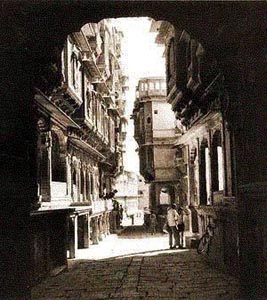
This status belongs to the dense network of havelis in the town below the fort – the private houses of the rich and wealthy, and the noblesse, who in the dwindling of royal power became the de facto rulers, an oligarcy very much like that of late mediaeval Venice.
The havelis of Jaisalmer are thus world-famous for their dense interlocking structure and their architectural devices which keep out the heat and dust. Many examples of modern Indian architecture take their inspiration from Jaisalmer’s urban planning and house clustering pattern, a notable one being Raj Rewal’s Asiad Games Village built for the Asian Games at Delhi in 1984.
Jaipur
If Jaisalmer is famous for its havelis, Jaipur is known for its town planning inspired from ancient texts. The death of the Mughal emperor Bahadur Shah accentuated the influence of Maharaja Jai Singh II of Amber, who then embarked upon the construction of a modern capital in the plains – a metropolitan fort inspired by Kautilya’s Arthashastra.
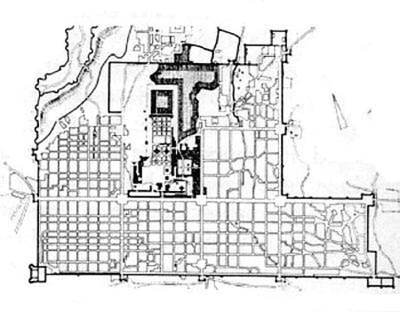 Like Kautilya’s ideal towns too, Jaipur is regularly planned. Its original regular nine-square geometry was however disturbed by military and esthetic considerations - the plan had to be modified to incorporate an existing garden palace at the ruler’s direction, and by displacing the north-west zone to integrate the defences with the hills there, extending to Jaigarh and Amber.
Like Kautilya’s ideal towns too, Jaipur is regularly planned. Its original regular nine-square geometry was however disturbed by military and esthetic considerations - the plan had to be modified to incorporate an existing garden palace at the ruler’s direction, and by displacing the north-west zone to integrate the defences with the hills there, extending to Jaigarh and Amber.
Within the walls, the original garden palace was follows the precepts of an ideal Kautilyan complex.
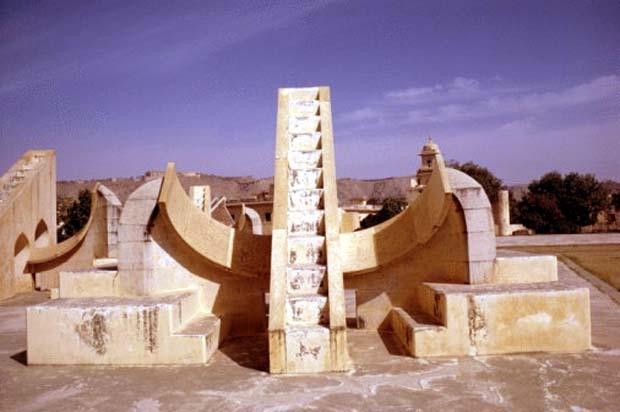
Images:
Interior of Amber Fort under license with Gettyimages.com
Peacock Gate at City Palace, Jaipur under license with Gettyimages.com
Golden Temple, Amritsar under license with Gettyimages.com
Wealthy merchant’s house, Jaisalmer © Martin Wierzbicki www.photosbymartin.com
Urban Structure, Jaisalmer by Raj Rewal
Jaipur Observatory (Jantar Mantar) under license with Gettyimages.com
25-Apr-2004
More by : Ashish Nangia